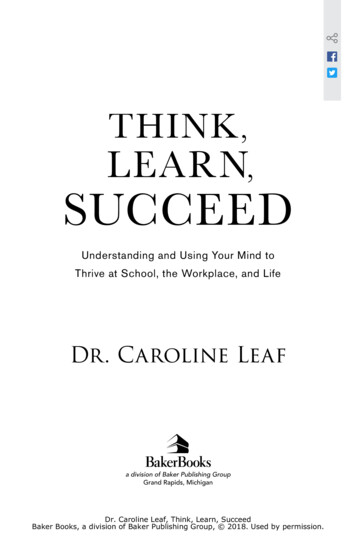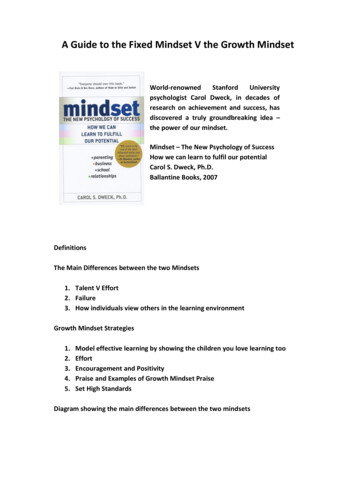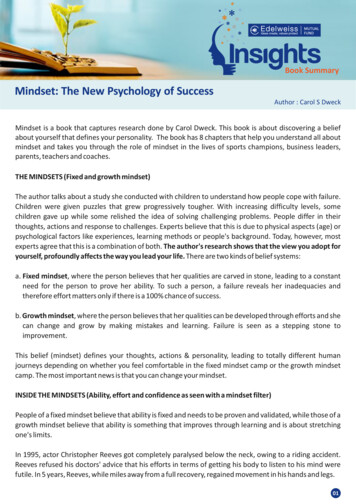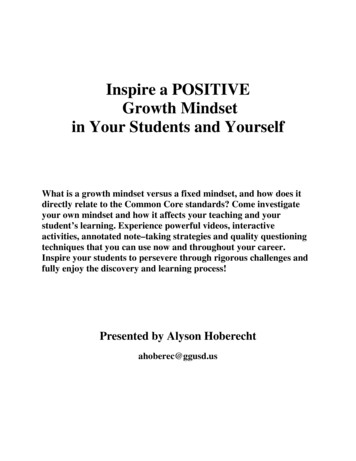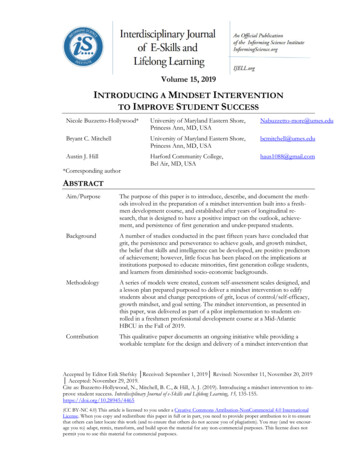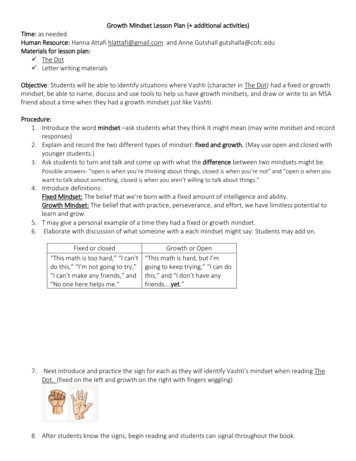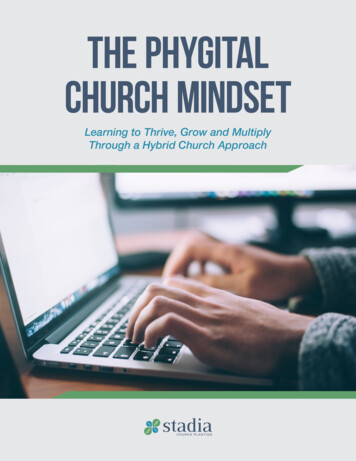
Transcription
The PhygitalChurch MindsetLearning to Thrive, Grow and MultiplyThrough a Hybrid Church Approach
Forget the new normal - we as the Church are aching to go back to the waythings were just a few months ago. Coronavirus has affected the Church, andculture overall, in many ways. Specifically for the Church, the ability to not gathertogether physically or worship corporately has dealt a tragic blow. For much of2020, many churches floundered trying to find a way to engage without beingphysically united. And in truth, the loss of physical engagement has actually hurtmany churches. Barna’s David Kinnaman suggests that 20% of churches willshut down by early 2022 - a percentage greatly accelerated by the pandemic.Additionally, an estimated 30% of Christians have walked away from the Churchduring the recent Coronavirus season. As quoted recently on a Carey Nieuwhofpodcast, “barring a genuine move of God and radical discipleship, statisticallywe’ve lost the church. We cannot get it back by human means.”We can all understand, then, the desire for churches to get into a time machineand go back to February 2020, living a ministry life “the way it used to be.”Unfortunately for us all, time machines have yet to be created. But even if theydid exist, should we actually go back? Was February 2020 really a highlight in thehistory of the Church? Barna has been doing some research in these areas, andChurch, the fact is - this isn’t Covid’s fault.The Phygital Church Mindset2
Egypt Really Was That BadThe hard truth is, church attendance has been down for over a decade. Generallyspeaking, February 2020 was par for the course - yet another example of churchattendance, community, and giving continuing to drop across most churches.Why would we want to go back to February 2020? It’s a little bit like the Israeliteswandering around the desert before they could get to the Promised Land: “Whydon’t we go back to Egypt? Pharaoh really wasn’t that bad. Who cares if we werebeing killed, or confined in slavery? At least we got three square meals a day!”Church, romanticizing the past won’t help us in the future. COVID was not thematch - it was merely gasoline on the flame. Coronavirus didn’t change culture,it accelerated it - and for the first time in remembered history, the Church wasfaced with the reality that we relied too much on our buildings. Pre-COVID, whilethe rest of the world was moving their livelihood online, the Church ignored thesocietal shift to digital. In fact, only about 10% of American evangelical churcheswere even broadcasting services online before the pandemic. And the numberof churches who were doing any sort of discipleship processes online? Very,very few - less than 200 in 2019. Compared to the estimated 330,000 evangelicalchurches in America, that’s fractions of a percentage point. Before COVID, weas the church clung to our physical models of ministry, while the rest of theworld moved online - and our attendance, our giving, and our engagement havedropped drastically as a result.The Phygital Church Mindset3
Pursuing the Right MissionThough tempting to think so, the answer to the Coronavirus problem is not ourphysical buildings. The endgame of our churches is not physical ministry. Andbelieve it or not, even in this digital-centric post-COVID world, the goal is not theexclusive use of digital for church. Physical. Digital. These models are extremelyimportant. But really, they’re simply tools used to help us get to our true goal.What are we, the Church, called to? To go and make disciples of all nations,baptizing them in the name of the Father, Son, and Spirit, and teaching them toobey Jesus’ words. Matthew 28’s Great Commission applies to all followers ofJesus - so why should that not still be our goal? For most of us, in this new mid/post-COVID world, it’s going to take both physical and digital tools to be effectivein living out Christ’s final command to His Church.DEFINING THE PHYGITAL CHURCHChurch, if there’s one lesson we need to learn from this COVID season, it is that tobe effective in going, making, baptizing, and teaching, we need to be PHYGITAL.We need to utilize the strengths of physical church and the strengths of digitalchurch. We have to find ways to get these two models of church to work together.Even before Coronavirus hit, Stadia Church Planting has been helping churchesdevelop a phygital mindset. Essentially, Stadia is helping churches learn how tothrive, grow, and multiply - both physically and digitally. But how do these twomodels work together?Phygitally.The Phygital Church Mindset4
The Strengths of Physical DigitalIf your church has tried broadcasting weekend church services online, you’veprobably asked yourself this question: “Who are these people watching ourchurch services?” Truthfully, the hardest thing in Church Online is discoveringwho these people are. During Easter 2020, there was a church that reported500,000 people in attendance at online and television services - half a million inthe audience! But when asked the number of people who filled out a connectioncard or gave the church any sort of contact information? The number shrunkdrastically to only 11 people. Half a million viewers. Less than a dozen peoplewanting tangible, on-going ministry.Meeting the new people watching a church service is extremely difficult online,while in a physical space it is very easy to engage new people physically. There’sthe unwritten social contract that you can’t walk out of a physical service when thepreacher is talking. The perception that a person walking out would be awkwardis a big win for the church, ironically. While we get the benefit from having acaptive audience in physical space, digital has no captive audience. Simply clickthe red “X” and leave the church service virtually unnoticed! In a physical context,social rules play in our favor.The Phygital Church Mindset5
Physically, when a person (at the appropriate time!) stands up from their seatto leave the physical worship center and walk to their car, your church probablyhas forty-seven (give or take a few dozen) volunteers, staff, or pastors positionedbetween that seat and their spot in the parking lot ready to shake hands, hug,meet, pray, sign them up for different church programs The list goes on.This is really the strength of physical church and corporate worship - meetingpeople. Don’t know someone? Walk over to them and extend your right hand.Hopefully they reciprocate. Convenience is also on our side at the physical church.Providing new people with easy on-ramps is simple when they have to say yes orno directly to your face. “Yes, I’d love to sign up for a small group!” “Sure, I guessI can attend your four week membership class.” “I love Kids! Why wouldn’t I servein Kids Ministry?”Once our new people hit the parking lot and get into the car, however, convenienceis now gone. It’s not convenient for them to travel across the city to go to thatsmall group. And while they may eventually do a membership class for a week,very few take it as far as that fourth session. Serving? The background check ortraining is often too much inconvenience, much less actually serving regularly.So, while church services are very strong physically, the other parts of ministryare often less convenient physically. And in 2020, like it or hate it, people will dowhat is convenient for them to do.This is where digital begins to shine. Sure, online church services make it difficultto meet new people. But the single mom can attend an online small group at9pm after the kids go to bed? The commuter doesn’t have to drive across townto someone else’s house? Suddenly, online sounds great.In fact, churches that are doing online discipleship are reporting getting peopleconnected to groups, serving, and giving faster than churches that disciple onlyphysically. If Amazon and other e-Commerce sites have taught us anything, it’sthat people like convenience of online. Moving our discipleship process onlinewhile maintaining the connection of physical church is a sure-fire way to get yourchurch thinking phygitally.The Phygital Church Mindset6
The Phygital Standard: Onlineto OfflineBut can we really disciple people online? Many churches have struggled with theidea of doing online discipleship, as they view digital as a platform not capableof creating true disciples. Some would go even farther and say that digital is onlycapable of creating consumers. Is it worth doing digital church if we can onlycreate consumers through that effort?The clear answer is no - but the problem here is not with digital church itself.Instead, the issue actually lies in our low expectations of a digital platform. As inthe physical church, our digital standard is not to create consumers, but to createdisciple-makers. We can set and live up to a higher standard for digital churchthan we as a church have been known to do. And that higher standard is this:Online to Offline. Simply put, the Gospel that we learn in our online world has toinfluence our offline relationships.A simple example of this idea: if someone identifies as a Christian on Facebook,but is physically abusive to their spouse, verbally abusive to their kids and stealsregularly from their workplace, then what kind of relationship with Jesus are theytruly experiencing?The Phygital Church Mindset7
Because the undeniable truth is, we are both physical and digital beings. We existin both spaces, and our presence in both digital and physical spaces needs to beconsistent. Galatians 5’s Fruits of the Spirit (love, joy, peace, patience, kindness,goodness, faithfulness, gentleness, self control) must show up in our digital lifeas well as our physical life - consistently. James 1:22 (in a modern paraphrase)best exemplifies this online to offline framework: Don’t just be hearers of theWord [online] and so deceive yourselves. Do what it says [in the real world.]*That Time Jesus Taught Us How to MakeDisciples (Online)Let’s put some legs on these ideas. You know who was really good at creatingdisciples who can create disciples? Jesus. (Pardon the Jesus-juke.) Early on inhis ministry, Jesus had to choose between having a large following of consumers,or start with a small group of movement-making disciple-makers. John 6 gives usa play-by-play of how Jesus mastered reach and engagement several thousandyears before social media was invented. It’s through this formula that we will notonly have a growing, thriving, multiplying digital presence, but that our physicalrealms will be greatly impacted, as well.REACH: John 6:2 // Jesus achieves reach throughthe “great crowd”.“And a great crowd of people followed Him because they saw the signs He hadperformed by healing the sick.” JOHN 6:2 NIV Meeting people’s physical needs made Jesus popular. But meeting those needswas also done in a spirit of humility. Jesus didn’t gain anything from the healings- He was doing these miracles first, because He is love, and second, to allowpeople to have exposure to him. That exposure was important, because exposure*Citation: The Online to Offline idea presented here was developed by Jay Kranda of Saddleback ChurchThe Phygital Church Mindset8
to Jesus is the first step to truly knowing Him. In digital terms, Jesus healing thesick is “reaching” people. The crowd is aware of the healings and starts to takenotice. But to say that they were disciples or disciple-makers wouldn’t have beentrue yet. They’d been reached. And reach matters.In fact, reach is vital in any Phygital Church.* People have to have exposure tothe church to start on the path to discipleship. You can’t start a movement withconsumers - but you also can’t start a movement if no one knows you exist tofollow.*As a note, it’s also true that in a lot of churches today, reach is overvalued. It is seen as the metric of whether achurch is successful or not. But in John 6, there’s no sense that Jesus was measuring the success of his ministryby his reach. He would have healed people if no one noticed - conversely, He didn’t change his methods whenthousands followed Him. He had a mission that He pursued no matter what. His unapologetic commitment to thatmission helped him to reach many people. Reach was a beautiful byproduct of His mission - not the goal.The Phygital Church Mindset9
FOLLOWING: John 6:11 // The crowd expressesphysical needs, and Jesus meets physical needs,adding to the crowd’s number.“To turn reach into following, you need to provide some value for “the crowd”- something that makes people want to take the next step and follow you. InJesus’ case, that value add was the way He continued to meet physical needs.It’s important to notice here that, during these periods of reach and following,we don’t see a lot of two-way conversation happening. It’s almost like the crowdwas observing the show, caught up in the spectacle of the action. They werefollowing Him (quite literally) in the biblical text to see what He would do next.It’s clear later on in Scripture that the crowd didn’t understand the implicationsof following Jesus, but they followed nonetheless. At this phase, the crowd wasacting a bit selfish. “What can you do for us?” “How can you meet our need?”“How can we be entertained?” And that was okay. Jesus would challenge themto discipleship later.Today in 2020, how can we reach people in a way that makes them follow whether or not they fully understand the implications to start with? Our churchservices, both physically and digitally, are losing value. Maybe it’s time for afresh playbook, a fresh approach to reach people today. In today’s social medialandscape, what does it look like to reach in order to connect with someonedigitally - to get them to click “follow”?What can we do for people? How can we meet their needs, digitally and physically?What can we do to connect?ENGAGEMENT: John 6:26 // The crowd looks to Jesusto meet more physical needs, and Jesus engages.Here’s the problem with being popular. People want more of it. Jesus, throughHis signs and miracles, was excellent at meeting people’s physical needs - whichThe Phygital Church Mindset10
just meant that people wanted to see more of their physical needs met! Thefollowers, the consumers, were looking for more to consume.That was when Jesus, for the first time in this story, engaged. (And here, we’redefining engagement as a two way conversation.) Jesus began asking questions.He dialogued with the people. And it’s important to notice here that the audience,for the most part, didn’t take it well.The wisdom of Jesus in John 6 is astounding. He knew how long to keep peopleat this crowd/follower level, and at what point it was necessary to turn the cornerand take the crowd to the next level. Jesus was very intentional in making thecrowd wrestle with hard concepts that would eventually weed out the consumersand keep the true disciples around.DISCIPLING: John 6:66 // Jesus’ engagement scarespeople away.“From this time many of his disciples turned back and no longer followed Him.” JOHN 6:66 NIV Once Jesus engaged, He didn’t water down his words. He came on strong, andthe people were taken aback. “This is a hard teaching. Who can accept it?” (6:60)was the response of many of those who had been following Jesus. Originally,people were connecting to Jesus for what Jesus could do for them. Throughengagement, people began to leave as they realized that this relationship wouldcause them to need to do things for Jesus. Like a college professor weeds outthe would-be doctors who squirm at the sight of blood, Jesus was filtering out thecrowd, in order to keep those that were really capable of being a disciple-maker.If Jesus had wanted numbers - consumers - He could have kept on filling people’sneeds forever. But He didn’t try to keep the crowd gathered and celebrate themega-ness of the numbers. Instead, we see that at the end of the conversationthat many of His disciples “turned back and no longer followed him” - leavingJesus a smaller group to work with, but a group He knew would be committed tobeing discipled and making disciples.The Phygital Church Mindset11
Jesus’ Lessons for Phygital ChurchThrough digital church, our reach numbers have been astronomical. Early COVIDsaw borderline ridiculous numbers across the country as people connected toour church services online. We were reaching people like never before!The problem is, Church, that we forgot to engage people. Challenge them.Disciple them. We celebrated the reach, but we were shortsighted. We forgotthat Jesus didn’t celebrate His own reach only. Instead, He took the opportunityto filter that reach down through His disciple making process in order to get thepeople capable of starting a movement.Church, let’s really look at ourselves. If our digital efforts are creating reach withoutmoving people to discipleship, is it the fault of the digital platform? Or are wedepending on our content to do the work that only engagement and discipleshipcan do?The Phygital Church Mindset12
THE VALUE OF CONTENTOur church services (whether physical or digital) are losing their effectiveness inturning consumers into disciples. The reason is that we as the church need tounderstand the idea of content - and more specifically that in 2020, the value ofcontent is non-existent. Think of these content giants: Netflix is 12.99/mo.Hulu is 5.99/mo.Disney is 6.99/mo.Apple is 4.99/mo, with 12 months for free.HBO is 15.99, or free with AT&T Mobile account.Prime Video is free if you are an Amazon Prime member.For 2 a day, you can have access to more content than you could engage with ina lifetime. But the truth is, we aren’t loyal to any of them. When our favorite seriesgo on season breaks, our interest in other content on a given platform drops. Orwe consume all the content we wanted when we signed up, and can easily click“cancel” without any FOMO. As consumers, we watch the things we judge areworth consuming. We are the judge, jury and literal executioner.Content: Losing the Battle, butWinning the WarWith this in mind, let’s talk practically here - and Pastor, I don’t mean to offend.But there is a better communicator than you. There’s a better worship leader thanyou have. Someone is doing better video production. There’s always a betteraudio mix or a more creative service flow. In the world of excellence, the localchurch will lose the online content battle because there will always be someonebetter (and when you add in personal preferences, “winning” content becomesa moving target). When this happens, consumers in your church (physical oronline) will drift away, because they’ll always go where they perceive there isbetter content to consume.The Phygital Church Mindset13
I have a friend in Miami who was active in a local church, but has started attendingNorth Point Church in Atlanta digitally. His family has been waning interest in thelocal church they attended for years. COVID has opened their eyes to the factthat there are other options than local. If all we are measuring the church onis content, then convenience and quality will continue to win. Your church willincreasingly lose the content battle post-COVID. If church is only defined by itscontent, does it really matter where we attend?Even in a season when much of church has to be online, our churches have to bemore than content. Content alone is not the answer. We need to think differently.Content may get us so far with our reach - but it will get us nowhere in makingdisciples.So what does move someone from reach to discipleship? Conversations that divedeep. Praying with someone in need. Giving sacrificially. Transparency. Jesus ispretty clear in Matthew 18: “For where two or three gather in my name, there amI with them.” Matthew 18 doesn’t challenge us so much to considering reach, asmuch as it does to considering engagement.Pastor, content is not the answer, digitally or physically. Online services alone arenot the solution to the problem. Mile wide, inch deep won’t work post-COVID.In truth, I’m not sure it was really working pre-COVID. To move people towarddiscipleship, we must build relationships with people. We must know peopleby name. We need to listen to their stories. We should help them see God’spurpose for their lives. Just like a physical church without face-to-face interactionis stunted, a digital church without a robust plan for truly engaging and disciplingpeople is also doomed to fail. But in a world run by the convenience of onlineplatforms, we must be willing to use both physical and digital spaces to movepeople from reach to discipleship.So let’s give up the content battle in order to win the war. This is how the Kingdomwins - not via content distributed to masses, but by conversations had where twoor three are gathered, physically, or even digitally.**Note: Ali Roohi’s church, CenterSet, is a great example of this. In a recent The Church Digital Podcast, Ali sharesabout how his church online attendance has dropped greatly - yet his small group attendance has tripled, andgiving has increased. Why did this happen? Listen to Ali’s words, directly.The Phygital Church Mindset14
STARTING A PHYGITALMOVEMENT STARTS WITH YOU“It’s For Someone”So here is the challenge, Church. What would our churches look like if, coming outof this COVID season, we were more focused on the disciple-making approach,in whatever space we employ it, than trying to celebrate how effective we wereat reaching a digital crowd or how many people gathered in our building on aSunday morning?On a recent episode of Marketing Guru Seth Godin’s Podcast, Seth was askeda question: “If you were to start over now in 2020, what steps would you followto build an audience that you go deep with?” Seth’s answer may surprise you What’s the smallest viable audience, the smallest groupof people that you could connect with, that you couldinspire, that you could change, that you could makea living with and for that would sustain you on yourjourney? Because the answer is not a billion people.It might not even be 100 million people or 10 millionpeople or a million people. And the place we begingetting trapped is saying, This is for everyone. “It’s sogood. It’s for everyone.” How do I get the word out?The alternative is to say, “It’s for someone.” How can Ibe specific?- Seth Godin, Akimbo PodcastWhat Seth eloquently states here is what we all already sense. To explain througha musical example, while it was once achievable for Beatles or Michael Jackson toachieve musical-godlike status, today, even rock gods like U2 pale in comparisonwith some of their early pioneers of Rock. Music is a prime example of genresThe Phygital Church Mindset15
becoming sub-genres becoming sub-sub-genres. A simple Google search foundover 40 Rock sub-genres, and though some may be able to appreciate the minutedifferences between Acid Rock, Death Metal, Doom Metal, Gothic Metal, andSpazzcore, in a world where there are so many options to solve so many desires,would it ever really possible for everyone to truly love a single band?Think about it. When is the last time we as an entire people agreed on anything?This is what Seth Godin understands, better than most. 2020 culture has brokenus all down into smaller sections. You’ll never be able to reach everyone or makethem all happy.If you want to impact the world, you don’t try to impact a billion people. If youwant to impact the world, you impact an individual, and then do it again and againand again. As church leaders, we are not dealing with one giant world. We’redealing with many, many smaller groups of people within our world. The churchmust begin to reach people in their sub-genre’d lifestyle.The Phygital Church Mindset16
Our Mission is Not A BuildinGBut how? In this COVID season, it seems like most churches are stuck when itcomes to evangelism, or getting people “on mission”. That’s because, when wetry to reach every genre, it’s very easy for us to lose our focus.Pre-COVID, our churches (at least, thriving ones) had “ones” that they were ledto reach. This pales in comparison to the Church’s potential once we understandthat our “ones” have “ones”, as well.And yet, with all these “ones”, church attendance is dropping. And post-COVID,our buildings will continue to lose their influence. We must begin to expect morefrom our people. Disciple-making is the future of our churches (there’s a strongargument that it should have been the expectation pre-COVID, as well - but,onward and upward). Once we utilize disciple multiplication techniques, we’ll findthat our buildings are actually a lid to ministry. Only so many bodies can fit insideour physical church spaces - but discipleship can happen anywhere.With the “loss” of our physical meetings, today’s Church has too often forgottenits true mission. Before, we were too content to let our evangelism be found in ourone hour on Sunday. Feel our powerful worship. Listen to our impactful sermon.Let your spirit be moved. (Extra “spirit” if you’re using a Haze Machine.) And it feltlike we were doing what we were called to do.Perhaps this is why we’ve missed our buildings so much during COVID - becausethe convenience of seeing faces and saying hello made us believe we wereeffectively discipling our people. It’s questionable whether that method was trulyeffective pre-COVID in reaching people who were cold to Christ. Is that reallygoing to work once we have free use of our spaces?Have we mistaken the call of the Great Commission - the call to go, make, baptize,and teach disciples - into some call to get back into the building?Pastor, don’t freak out because your people are not in your building. Freak outbecause your people don’t have purpose when they’re not in your building.The Phygital Church Mindset17
Pastor, What If.What if we, in this current reality, stopped looking back longingly at the perceivedbenefits of our physical spaces, and instead took a phygital approach? What ifwe helped define a purpose for our people by revolutionizing our disciple-makingapproach by doing it digitally? Instead of a heavy focus which measures successbased on one hour on Sunday, we must begin to equip disciple-makers to reachtheir circle of influence all 168 hours a week. When the building is paramount, ittruly is a lid to your ministry. It’s a limiter. It doesn’t enable ministry within yourcommunity. Instead, it boxes the ministry in, preventing it from going out.But have no fear. Even if you have fallen into the trap of thinking your space isthe only place that discipleship can truly happen, COVID is forcing you to thinkdifferently. It’s forcing you to think phygitally. Now, it’s time to take what you’vestarted in the time of Coronavirus and create a cohesive discipleship plan thatincludes all the spaces your people occupy.Phygital discipleship doesn’t mean that you should strive to create a virtual buildingfor people to gather in. Instead, true phygital presence requires a combination ofphysical and digital ministry, where digital avenues become a distribution networkfor the Gospel through our trained, equipped, and mobilized disciplemakers.Who wants to go back to February 2020? God has His Church exactly where Hewants us to be.The Phygital Church Mindset18
DEFINING THE DIGITAL CHURCH:TOMORROW’S APPROACHSTARTS TODAYThere is only one Church, one Ekklesia, one Bride of Christ. However, as we arewell aware, there are many different ways that the church manifests itself. Gigachurch, Mega-church, Micro-church, House-church - these are just a few of themany multi-modal options for expressions of church in the US (and around theworld). COVID, being the accelerator that it has been, has opened the door for anumber of other relevant options for the Church to grow into.Remember, all of these models are just models. We’ve already seen that churchbuildings will likely continue to lose influence in a post-COVID reality, and thatfleshing out a phygital discipleship plan is the only path forward if your churchis to thrive. It’s never been a better time for digital solutions to fill in gaps atyour church. As you think about moving into the phygital landscape (or startingnew churches with phygital in their DNA), here are some burgeoning models theChurch could take today to help it be more effective tomorrow.Phygital (Physical Digital)Phygital churches use the strength of our physical buildings, as well as thestrength of online arenas to create disciple-makers. Remember, the endgameof our ministry is not buildings. Neither is it digital engagement. The endgameof every model of church is Matthew 28’s Great Commission. Our buildings andour digital strategy are means to the end, not the end. However, historically, ourbest ministry efforts have been poured into physical spaces. Any size church thatexisted pre-COVID now needs to focus on strengthening their digital approach,and integrating digital into the church strategy moving forward. (Why? Thestrength of digital to a church isn’t “Reach”, it’s “Engagement”.) A phygital churchmay not replicate the entirety of the Church in an online space, but it will utilizethe strengths of physical and digital together with intentionality.The Phygital Church Mindset19
Phygital: Digital-Next (Digital Church Moving AwayFrom Physical)There’s a phenomenal opportunity for churches that are struggling, in thequestionable economy, to pivot towards a digital model of church. Many smallchurches have lost their building lease in this season. Literally, churches arehomeless. In addition, churches overall are struggling economically. How muchdo our buildings cost? What of maintenance? Staffing for building usage? Insteadof forcing back into a physical model that a church may not be able to afford,there may be wisdom in developing a digital model that leans towards a disciplemaking micro-location to extend the life of a church, while still helping the missionof the church within the physica
Church Mindset Learning to Thrive, Grow and Multiply Through a Hybrid Church Approach. Th hygita hurc indset 2 Forget the new normal - we as the Church are aching to go back to the way things were just a few months ago. Coronavirus has affected the Church, and culture overall, in many ways. Specifically for the Church, the ability to not gather

